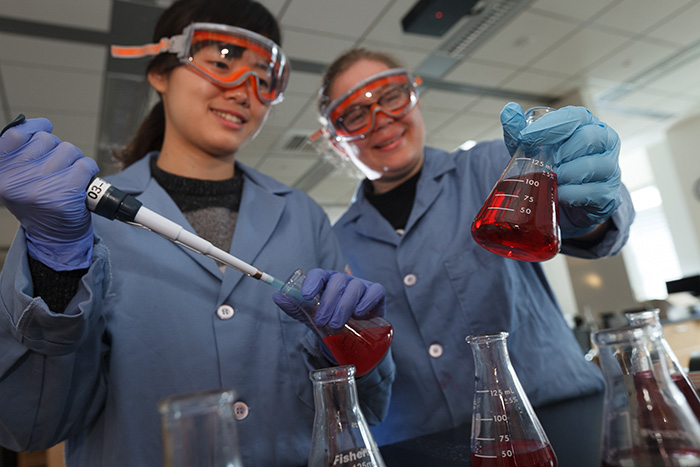The Science of Salad

Class of 2019 members Lena Friedman and Haeji Chung measured changes in the absorption rate of antioxidants in fresh and canned farm beets, versus fresh and canned store-bought varieties. Photo by Carl Socolow '77.
Farm-to-Lab project examines the chemistry of food
by MaryAlice Bitts-Jackson
Healthy food is a pathway to a healthy life. But which foods pack the biggest nutritional punch? Students in a first-year chemistry class took that question to the lab, measuring nutrients in food produced at the College Farm, compared to supermarket fare.
The experiments, which are just one of the many ways Dickinson incorporates active learning into courses at all levels, were part of a 100-level class taught by Associate Professor of Chemistry Sarah St. Angelo. One included a study of antioxidants such as vitamins A and C, which have been found to prevent or delay cell damage that can contribute to health conditions such as infections, cardiovascular disease and some types of cancer.
After visiting the College Farm to get an up-close view of day-to-day farm production and trying their hand at various farm processes, the students designed and conducted original research to determine which kinds of edibles had the highest levels of antioxidants. And on Nov. 4, they shared their findings during a poster session in the Rector Science Complex Atrium.
Confirmations and surprises
The students had hypothesized that local, organic fare would be more nutrient rich than conventionally farmed food. And in nearly all cases, the lab work corroborated the students’ hypotheses—in some cases, dramatically.
Carlin Smith ’19 and Alex Medeiros ’18, for example, determined that College Farm broccoli had a full 1.90 times the amount of vitamin C than their conventionally farmed samples. Hieu Le ’19 and Richard Barron ’19 also uncovered marked differences in the nutritional values of three different varieties of tea (of the three samples, green tea was by far the most antioxidant rich).
“I usually drink green tea anyway,” Le said, looking over his results, which are in tune with numerous studies worldwide. “After this experiment, I’m definitely going to continue.”
But there were three research teams that encountered surprises in the lab.
Lena Friedman ’19 and Haeji Chung ’19 measured changes in the absorption rate of antioxidants in fresh and canned farm beets, versus fresh and canned store-bought varieties. The fresh College Farm beets had significantly higher concentrations of antioxidants than the store-bought, but the farm’s canned beets had slightly lower levels than those bought at the store.
“That was a big surprise,” said Friedman, who plans to combine her interests in chemistry and sustainable agriculture, possibly by continuing this research. “Our guess is that there is a difference in the canning processes that accounts for the discrepancy.”
Amanda Allan ’19 and Alexandra Ellerkamp ’19 came to a similar conclusion when they discovered that their samples of store-bought, organic baby food had comparable—and, in the case of peas, greater—levels of antioxidants than baby food they made themselves, using organic ingredients (Ellerkamp believes the team’s cooking processes, and perhaps manufacturer additives, are to blame).
Data and impact
Matthew Trang ’19 and Maxwell Yoshida ’19 also were taken aback when they did a comparative analysis of farm and store-bought kale and baby kale. Trang, who uses farm kale to make smoothies at The Juice Box, was pleased to discover that farm kale trumps the store-bought variety, but he was surprised to learn that store-bought baby kale has the most nutrients of all. He and Yoshida suggested to College Farm staff that they should harvest kale before it matures, when it is at its nutritional peak.
Farm Director Jenn Halpin was grateful for the news. “Having data to support overall health benefits associated with certain crops grown on our farm provides us with helpful information to share with customers and helps inform how various production methods impact the quality of the produce that we grow,” she said. “Research outcomes also prompt more questions and hypotheses that we hope to investigate further through future course collaborations and student research.”
Learn more
- Active Learning
- Department of Chemistry
- “Lab, Field or Office?”
- “One Room, 60 Discoveries”
- Dickinson College Farm
- Latest News
Published November 11, 2015